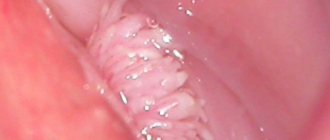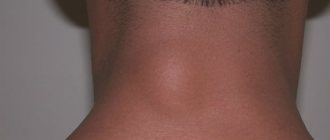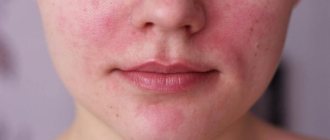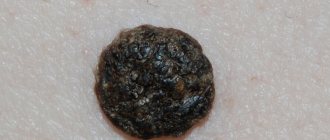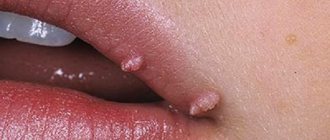Why remove papillomas
Removal of tumors is carried out for several reasons:
- The emergence of oncology. Papillomas are considered benign neoplasms that do not harm human health. However, over time, their growth can progress and they change into malignant formations, resulting in the development of cancer.
Papillomas grow in colonies
- Constant contact with clothing. Often, papillomas are localized in places where the skin comes into contact with the tissue, causing the tumor to rub. A damaged growth can become an entrance for infection, which can subsequently lead to suppuration.
- Possibility of infecting others. Contact with papilloma can transmit the infection from a sick person to a healthy one. This is especially dangerous if the growths are on the genitals. In this case, the partner can become infected with HPV during sexual intercourse.
In addition, an external defect is a source of bad mood. Even small papillomas can become a cosmetic problem that a person will try to hide with clothing.
Removal methods
Removal of papillomas always begins with a consultation with a dermatologist. The doctor will examine the affected area and determine the most appropriate way to remove the growth. Each method has its own indications, advantages and disadvantages.
Surgical method
This method is one of the oldest methods for eliminating papillomas and is considered the most radical. Despite the abundance of more modern procedures for removing growths, surgery continues to be used. It is prescribed if the tumor has reached a large size, and after its removal a histological examination is necessary.
The principle of this method is based on excision of the papilloma with a scalpel, after preliminary application of an anesthetic. After this, the removal site heals over a long period of time and requires daily treatment with antiseptic agents.
Cryodestruction
It is based on the action of liquid nitrogen, which freezes the resulting growth. Its cells die and gradually begin to be rejected. At the end of the procedure, the papilloma does not go away immediately, but becomes white, cold and hard. After a couple of hours, a blister appears at the site of action of liquid nitrogen, accompanied by redness and swelling. It gradually transforms into a scab, under which the processes of skin healing and the formation of new cells take place. The scab can stay on the skin for up to 6 weeks, after which it falls off.
The method is often used due to its affordability, minor pain and short duration of the procedure.
The main disadvantage of cryodestruction is the possibility of scars appearing at the site of exposure. This can happen if the skin in the affected area is too thin or the papillomas are located deep in the folds of the skin. Also, the use of liquid nitrogen does not make it possible to completely control the depth of penetration of the substance, which can also lead to complications after surgery.
Typically, complete recovery takes 3-4 months, but in some cases this time can be extended to six months.
Laser therapy
It is one of the most progressive methods that allows you to remove several growths at once in one session. The neoplasm cells evaporate under the influence of a laser beam, as a result of which the papilloma disappears. In parallel with this, the process of sealing the capillaries occurs, which helps prevent the formation of bleeding. Before the procedure, the patient should not be in the sun for a long time or visit a solarium.
Advantages of the method:
The resulting crust disappears within a few days after surgery. It should not be touched, smeared with cream or wet. There will be a pink spot underneath, the color of which will gradually become equal to healthy skin after 3-4 weeks.
Laser therapy is not used for large growths larger than 5 mm.
Electrocoagulation
The method is based on the influence of high-frequency current directed to the site of the virus. Radiation promotes tissue destruction, resulting in skin necrosis. This method is good for protruding papillomas or those that have a thin stalk. If there is a stalk, the growth is eliminated quickly, but if the tumor protrudes above the skin, several repetitions may be required.
The procedure has a number of advantages compared to other methods:
- electrocoagulation instantly seals the vessels, which helps stop bleeding;
- the excised papilloma can be taken for histological examination;
- the skin is restored quite quickly;
- the price of the procedure is low.
If necessary, a local anesthetic can be used before the procedure to alleviate the patient's condition. During the operation, direct contact of the electrocoagulator with the skin occurs, so the site of exposure needs daily treatment after the procedure.
The spot that appears in the area of the former papilloma disappears within several weeks. During this time, it is necessary to avoid prolonged exposure to the sun. Electrocoagulation usually does not leave scars, except in cases where the growth is localized deep in the tissues.
Radio wave method
Also called the radio knife method. Most operations are performed using the Surgitron device, which is a new development of radio wave surgery. The essence of this method of removing papillomas is the effect of a thin electrode aimed at the location of the papilloma. A radio wave is supplied to the electrode, heating the cells, which evaporate under its influence. At the same time, it does not heat up and does not touch the skin, which eliminates the possibility of complications. The shape of the wave and its strength are selected based on the depth of localization of the growths and their type.
The main advantages of the method are:
- no risk of contracting an infection after a wound occurs;
- the ability to remove tumors in areas with thin skin without scars;
- short recovery period;
- the ability to eliminate papillomas even in hard-to-reach places;
- painlessness of the procedure.
After the operation, a small crust also remains at the site of exposure, which cannot be wetted. Full recovery takes 1-3 months. In the first two weeks, you should spend less time in the sun and avoid visiting the solarium.
This method of removal is not suitable if the tumor is too large.
Folk remedies against papillomavirus
You can try to get rid of small growths using a fairly common remedy - celandine juice.
You can try to get rid of small growths using a fairly common remedy - celandine or dandelion juice, which you need to lubricate the growth until it disappears completely. Human papillomavirus infection is afraid of castor oil and vitamin A. Castor oil contains an acid that helps the disappearance of papillomas. Astrologers also have their own opinions about the treatment of PVI. They believe that it is best to start removing warts and papillomas during the waning moon. In parallel with this, you need to strengthen the immune system by using herbal infusions. The course of such immunotherapy usually lasts at least 3 months.
But we must still remember that only a doctor, based on test results, can make the right decision about the need and methods of treatment. If genital warts are found on the body or mucous membranes, a dermatovenerologist, gynecologist (for women) and urologist (for men) can prescribe conservative or destructive treatment. Conservative treatment includes a set of measures to increase immunity and antiviral treatment. The main rule here is no self-medication! Only a specialist selects medications and the regimen for taking them.
If a papilloma appears on the body, it must be removed immediately. To do this, there are now several destructive methods - physical and chemical - that remove genital warts. Chemical methods of treatment involve removing condylomas using chemicals (for example, Solkovagin or Solcoderm). But the physical method is electrocoagulation, laser, cryodestruction, and radiosurgery.
If we talk about the most common and familiar method of removing papillomas, then this is electrocoagulation. With its help, skin tumors are removed using high-frequency electric current. Under its influence, the temperature in the tissues rises, and the papilloma is destroyed.
Although there is no bleeding, it cannot be said that the procedure is painless. The wound does not heal for a long time, causing discomfort to the patient. This is a minus of the electrocoagulation procedure. Cryodestruction is now also quite popular for removing papilloma. In this case, the neoplasm is exposed to liquid nitrogen for freezing. The method is painless, but using it to remove, for example, condylomas on the cervix is ineffective, and the recovery period after the procedure is about six months. The most optimal method is laser therapy.
Recommendations after removal
There are several rules that must be followed in the first days after papilloma removal. So, during this period you cannot:
- wet an unhealed wound;
- peel off the crust that appears;
- apply an adhesive plaster to the affected area;
- sunbathe in the sun or in a solarium;
- injure the skin (rubbed with clothes, a washcloth, scratched, etc.);
- apply creams or cosmetics to the affected area;
- allow chemicals to penetrate into the wound.
In the first days after surgery, it is necessary to devote special time to treating the wound to prevent infection. To do this, it needs to be treated with antiseptics - iodine or brilliant green. After the crust falls off, you can use ointments to help heal and restore tissue.
Disease prevention
The virus begins to actively manifest itself when a person’s immunity is undermined. To prevent a decrease in immunity, you should adhere to preventive measures:
- Safe sex. Condoms not only protect against unwanted pregnancy, but also reduce the risk of contracting sexually transmitted viruses.
- Healthy lifestyle. Fresh air, physical exercise, long walks have a beneficial effect on the general condition of the body.
- Nutrition. You should eat more foods that contain vitamin C: citrus fruits, tomatoes, kiwi, bell peppers.
- Herbal decoctions and freshly squeezed juices. Every day it is useful to consume compotes of berries and fruits, drink tea with rose hips and mint, and a decoction of lingonberry leaves. It is recommended to make juices from vegetables, berries, fruits, and herbs.
- Hygiene. Do not neglect the rules of hygiene when visiting public places.
- Visit to the doctor. Regular observations will help the doctor recognize the disease at an early stage and then take appropriate measures. The specialist may prescribe antiviral and immunomodulatory drugs.
Special vaccinations also protect the body from HPV. They will not completely destroy the virus, but will help a person effectively fight the disease throughout his life.
Complications
Even with the use of the most modern methods for removing papillomas, complications may arise after the procedure. Usually all the consequences boil down to redness, swelling and mild pain at the site of exposure. Such phenomena disappear after a few days. However, in some cases, this may be accompanied by the appearance of scars or spots in the area of papilloma removal. This can happen when:
- the location of the growth deep in the skin;
- choosing a removal method that does not correspond to the shape or size of the papilloma;
- lack of professionalism of the doctor;
- features of the procedure.
Also rare, but the most dangerous complication is wound infection. This can happen if the method of removing papilloma does not involve immediate tissue sealing or if the wound was poorly treated at the initial stage. In this case, you must consult a doctor for therapy.
Household treatments
There are many products for removing papillomas that can be used independently at home. Reviews about means of getting rid of tumors often characterize Stefalin ointment on the positive side. This ointment has a natural composition (a collection of Carpathian herbs) and is easy to use. The ointment does not leave skin defects after treatment.
You can remove papillomas with special preparations: feresol, condiline, verrucatsid, cryopharma, supercelandine or podophyllin, etc. Medical tape coated with a sticky composition that removes papillomas is often used. The tape is glued to the formation and after a week comes off along with it.
But it is still better to consult a doctor to eliminate risks.
Reviews
Ulyana, 34 years old:
“On the advice of a dermatologist, I removed the papilloma on the eyelid with a laser. No pain, no discomfort. More than 1.5 years have passed since the removal, there have been no relapses and no scars remain. I plan to remove another papilloma with a laser too.”
Source: nocik.ru
Causes of papillomas
It is believed that up to 70% of the entire population of the planet is infected with the human papillomavirus. Often, based on the results of the analysis, it becomes clear that a person is infected with 20 strains of the virus at once. But often the virus does not manifest itself for a long time, especially if the person has good immunity.
A non-specialist is unlikely to determine the type of neoplasm on the skin “by eye”
Infection with any of the HPV strains most often occurs through direct contact with a carrier of the virus, in which the pathogen can penetrate microtraumas on the skin and mucous membranes. The neoplasm forms directly at the site where the virus enters the body. The anogenital form of the disease is transmitted during sexual intercourse, in this case papules form in the folds of the skin of the perineum, on the mucous membranes of the vagina and cervix, in the rectum, urethra and bladder, and in men - on the head of the penis. On the outside, genital warts are mainly formed, and on the internal organs - flat papillomas. The oral cavity can be infected in a similar way. In this case, laryngeal papillomatosis occurs, affecting the mucous membranes of the mouth and throat.
A newborn can become infected with HPV from the mother during passage through the birth canal. In this case, the child most often develops anogenital papillomatosis, the strain of which is the most aggressive, or laryngeal, which can significantly damage the child’s vocal apparatus in the future and can even be life-threatening in severe cases due to airway obstruction.
However, to become infected with HPV, it is not necessary to have direct contact with the carrier. The virus can exist for some time outside the host’s body and be transmitted through household objects or in public places. Simply put, sometimes it is enough to hold on to the handrail in public transport and then touch your face, so that in a year or two a new growth will appear in that place.
Since the incubation period of the papillomavirus is quite long, several months or even years may pass from the moment of infection to the appearance of clinical signs. Usually the virus is activated and begins to manifest itself in the form of neoplasms when immunity decreases. That is why treatment should include not only the removal of visible manifestations of HPV, but also systemic immune therapy.
What causes formations, and in what cases do they need to be removed?
The human papillomavirus is transmitted in a variety of ways and often the carrier may not show visible symptoms. The most common method of transmission is sexual intercourse. But in some cases, the virus can be transmitted even by shaking hands. The risk of the virus awakening is highest when the immune system is weakened.
Development can be triggered by addiction to alcohol, excessive smoking, frequent illnesses, problems affecting the gastrointestinal tract and others.
HPV does not have the ability to penetrate organs, blood and other tissues. The virus is localized inside the cells of the epidermis, and reproduction occurs in the deep layers of the skin. At the moment of maturation, it comes to the surface in the form of papillomas and warts. In its dormant state, the virus is not dangerous to others.
Also, in order to protect yourself from contracting the virus, experts recommend refraining from visiting public places where human skin is least protected - baths, saunas, swimming pools, beaches. If the virus is detected in pregnant women, there is a chance that it will be transmitted to the child.
Papillomas are not painful and if they do not cause discomfort, then not many are in a hurry to remove them. In such cases, the main reason for removing the tumor is its appearance, because it is simply impossible to disguise it.
It is recommended to remove papillomas that are in close contact with clothing. After all, there is a high probability that they may be torn or injured, and this is often the cause of complications. It is imperative to remove a hanging mole on the face, neck, or armpit area - they are the most vulnerable. In the future, an infection may get into the formed wound, resulting in an inflammatory process, lymphadenitis, etc. If the formation has been disrupted, then treatment with hydrogen peroxide is required. Next, the wound is covered with a plaster. An examination by a specialist is also required.
Another indication for removal is the risk of its degeneration into a malignant form. Before choosing one of the methods for eliminating the formation, the patient undergoes examinations to determine whether the mole has caused the development of more serious diseases - for example, skin cancer.
Indications for removal:
pain when touching the formation;
- growth, bleeding and change in color of papilloma;
- growth size is too large;
- malignant nature of the neoplasm;
- pronounced cosmetic defect;
- spread of HPV to other areas.
Types of tumors caused by HPV
Not all clinical manifestations of papillomatosis are the same. Today, about 90 HPV strains have been typed and correlated with certain types of neoplasms. Based on the external manifestations of the disease, the following types of papillomas are distinguished:
- plantar papillomas, often called warts;
- simple, or vulgar, papillomas;
- flat papillomas;
- genital warts;
- filamentous papillomas.
Even a doctor cannot always make an accurate diagnosis based on appearance
Plantar warts
As the name suggests, plantar warts form on the skin of the feet and are characterized by internal growth, which distinguishes them from other types of neoplasms. They are usually solitary, but if left untreated they can reach impressive sizes, causing considerable discomfort.
Vulgar papillomas
Vulgar papillomas are also often called warts in everyday life. They grow from a small tubercle, gradually enlarging and darkening due to keratinization, and can merge with each other into formations of an indeterminate shape. Papillomas of this type are most often localized on the skin of the hands, less often on the knees, face, neck, and back. Like plantar pain, they can go away on their own.
Flat papillomas
Flat papillomas rise slightly above the skin, and their surface has a nodular structure. These neoplasms are not subject to keratinization (keratinization) of the surface, so they usually retain the color of healthy tissue or become slightly darker. They can appear on the face in the eye area and on the chin, as well as on the lower legs, arms, and back. A common symptom of vulgar papillomas is itching. Such neoplasms do not go away on their own, and an accurate diagnosis must be made by a doctor.
Condylomas acuminata
Genital warts are similar in appearance to cauliflower. Single neoplasms grow on a thin stalk, gradually merging with each other into large growths. Condylomas are localized in the anogenital area:
- on the external and internal genital organs;
- outside and inside the anus;
- in the perianal fold;
- in the urethra and bladder.
These neoplasms are precancerous and therefore must be removed, followed by subsequent therapy based on test results. Suffice it to say that in almost 80% of cases, cervical cancer is detected by this type of human papillomavirus.
Filiform papillomas
Filiform papillomas, otherwise called acrochords, grow on a thin stalk, which makes them easy to accidentally tear off, and are predominantly single, less often found in groups. Their main locations are the face in the area of the eyes and nose, inguinal folds, axillary areas and under the breasts in women. They usually have an oblong, elastic shape without keratinization. Rubbing with clothing can cause discomfort and damage. Acrochords cause mainly aesthetic discomfort and are susceptible to malignancy in rare cases.
An accurate diagnosis can be established using laboratory methods for studying tumors
You need to know the enemy by sight
Papillomas are skin neoplasms of a benign nature. The causative agent is the human papillomavirus, which is transmitted by contact. Warts can appear anywhere: both on the skin and on mucous membranes. The name of the neoplasm depends on which part of the body is affected. Experts highlight:
- Common warts. Initially, a small flesh-colored skin elevation appears, which then acquires a gray or brownish tint. Gradually they grow and take on a rough structure.
- Flat warts. They are more common in young people, which is why they are also called youthful. They rise by 1-2 mm, blend with the skin tone - therefore they are almost invisible. Favorite localization: face, back surface and fingers.
- Acrochords or filamentous papillomas. Affects the skin of older people. They usually appear on the neck, in the armpits, and in women they are found under the mammary glands. Conditions for their occurrence: thin sensitive skin, places of frequent friction.
- Genital warts. They are multiple small rashes in the anus and perineum. Due to their specific location, such papillomas are transmitted sexually.
- Plantar warts. Despite the obvious name, such papillomas can appear on the back and palmar surface of the hands. They do not need immediate removal because they are capable of disappearing on their own.
Diagnosis of papillomas
No matter how much you would like to get rid of annoying papilloma quickly and at home, or even better - with the help of some folk remedies, do not rush! Self-selecting procedures can lead to disastrous results. Be sure to visit your local clinic.
In a paid clinic, for your money, they will cut/burn/freeze anything for you without any questions asked, but there is no guarantee of an accurate diagnosis, and therefore the absence of undesirable consequences.
- a gynecologist or urologist if tumors appear in the perineal area;
- an otolaryngologist if papillomatosis of the mucous membranes of the mouth or throat is suspected;
- a dermatologist - in all other cases.
Based on the results of the clinical examination, the doctor, if necessary, may prescribe:
- collection of cells for cytological examination;
- tissue sampling for histology;
- scraping for PCR analysis;
- collecting material for the daijin test.
All these methods, in one way or another, make it possible to determine the risk of developing cancer. After removing the tumors by any method, it will no longer be possible to determine this indicator. This increases the likelihood of adverse consequences.
How to treat papillomas at home?
Treatment of papillomas at home with folk remedies - infusions and decoctions, homemade ointments - has been successfully practiced for decades.
For example, the popular name for celandine, warthog, is due precisely to the fact that the juice of this plant was used to remove warts and papillomas.
To remove papillomas in men and women at home, plants such as rowan, walnut, aloe and Kalanchoe, garlic, as well as many other “non-herbal” remedies are also used. We will tell you more about various home treatment methods.
This is interesting: Buy a beauty star laser pen for removing tattoos, papillomas, warts in Moscow for 3900
Chemical destruction
It is carried out using special liquid preparations based on acid or creams containing alkali. Such drugs are sold in pharmacies as prescribed by a doctor.
This method can be used to remove only single vulgar papillomas (warts) on the hands.
When using chemicals to combat tumors, special precision is required
Is it possible to get rid of papillomas forever?
Taking into account the number and variety of methods to combat papillomas, the conclusion arises that this problem is not so easy to solve.
In fact, by removing a tumor, it is impossible to guarantee one hundred percent getting rid of it forever, because papilloma itself is only a consequence, and the cause is the presence of HPV in the body .
The fight against viruses is based on the formation and maintenance of normal immunity. Therefore, when getting rid of papillomas, it is important to understand that a relapse will not be long in coming if the immune system is not in order.
The best way to solve the problem is an integrated approach - contacting a doctor and strictly following all points of the prescribed treatment, including taking immunomodulatory drugs.
Cryodestruction
A long-established and well-proven method of removing tumors using exposure to extremely low temperatures, in which the affected area is exposed to liquid nitrogen or other refrigerant for a short time.
The application of the refrigerant itself does not require preliminary anesthesia, because The application is painless, although the patient may feel a slight tingling or burning sensation. However, after the operation, during the “unfreezing” of the tissues, acute pain occurs, which can last up to a day. This is normal.
After a few hours, redness and swelling form around the injury, and a day later a subcutaneous blister filled with fluid forms. The rehabilitation period lasts a week, during which the swelling and hyperemia disappear, and the bladder breaks on its own. After this, it is necessary to apply an antiseptic drug prescribed by a specialist.
The death of tissue under the scab continues for three weeks, which ensures reliable destruction of infected tissue. Wound healing occurs in 1.5 months, and the mark completely disappears in six months, during which it is necessary to protect the skin from the sun and mechanical stress.
Radio wave coagulation
Removal of tumors with a radioknife occurs under the influence of directed high-frequency radiation, during which the affected tissue evaporates. The radiotherapy device has several electrodes of various shapes and purposes, which the doctor selects depending on the form of the tumor. The most widely used device in our country is the Surgitron device.
The procedure is performed under local anesthesia in the form of an injection. With this method, papillomas are removed quickly, without damaging healthy tissue, leaving almost no traces. There is no rehabilitation period here, but there are many contraindications to the use of this method. Radioknife is contraindicated for:
- exacerbation of chronic diseases;
- acute inflammatory processes;
- diabetes mellitus;
- pregnancy and lactation;
- presence of a pacemaker;
- oncological diseases of any location.
Radio wave treatment should not be used if there is a possibility of malignancy of papillomas. But in the absence of such, the method is successfully used on any part of the body. According to patients, the most unpleasant thing about this procedure is the anesthetic injection.
Laser coagulation
The modern non-contact method of removing tumors using a laser has become widespread not so long ago. Experts say that it is absolutely painless and low-traumatic, because... infected tissues evaporate without harming healthy ones. The procedure takes a few minutes, and the rehabilitation period lasts 2 weeks, during which you should refrain from swimming in the pool and open water, and avoid temperature changes and the sun.
The method can cause side effects such as prolonged skin redness and swelling; in case of thyroid problems, keloid scars can form. There are many contraindications for this type of treatment:
- diabetes;
- acute inflammatory processes;
- epilepsy;
- disorders of the endocrine and immune systems;
- photoderomatosis;
- thrombocytopenia and others.
According to patients, the procedure is very unpleasant and painful, and during the process “you can smell the smell of burnt meat.” In addition, healing takes a long time and relapses are possible.
Electrocoagulation
Used to remove small papillomas. Since the essence of the method is the thermal destruction of the affected tissue, the method is popularly called “cauterization.” A heated electrode is used to touch the neoplasm and coagulate it along with the vessels, resulting in a pinpoint burn that becomes covered with a dark crust within an hour. In the case of single papillomas, local anesthesia is used, but in the case of multiple small tumors this is inappropriate.
The rehabilitation period lasts about a week, during which the redness and swelling disappear and the dark crusts disappear. At this time, it is recommended to protect yourself from the sun and treat your skin with an antiseptic.
The use of this method is possible for any location of tumors, and patient reviews indicate its reliability. While the price for removing one papilloma is very reasonable, removing multiple tumors will cost a pretty penny.
Warts appear on the body after the human papillomavirus enters the body. Today, scientists have been able to identify about one hundred of its strains. Among them there are those that have a high risk of oncogenicity, which is why it is so important to consult a doctor promptly when characteristic growths appear. Early diagnosis, drug treatment and proper removal of papillomas can prevent the possibility of a benign tumor degenerating into a malignant tumor.
Types of papillomas
The first symptoms of infection do not appear immediately; the virus first goes through an incubation period, then enters a latent form and waits in the wings. The cellular parasite can be activated only under the condition of a sharp decrease in immunity; it is then that characteristic neoplasms begin to grow on the skin or mucous membranes.
They can be of different types.
- Simple (vulgar) papillomas grow on the palms, between the fingers and toes, and in the hollows under the knees. They are small in size (several millimeters), round in shape, with a rough, hard surface covered with a keratinized layer. They are formed after infection with strains that have low oncogenic risks.
- Juvenile papillomas on the body appear during puberty; their color practically does not differ from the color of the skin. Most often they grow on the face, neck, and on the back of the fingers or toes. Outwardly, they look like small tubercles with a flat top. When exposed to irritating factors, they may become red and itchy. These types of tumors are not dangerous, but if they cause psychological discomfort, they can be removed using hardware cosmetology installations.
- Plantar warts are very similar to dry calluses. But unlike them, they have clear boundaries, an irregular circle shape, and a gray or yellow color. When pressed, severe pain appears. Conservative therapy will not stop it, so when doctors detect plantar papillomas, they immediately offer the patient to remove them.
- Filiform warts do not grow outward, but upward. They can be small (1-2 mm) and large (about 2 cm). A distinctive feature is its soft structure, the presence of a stalk on which the body of the growth is located. Typically, filamentous warts grow in middle-aged people; they do not disappear on their own.
- Genital warts are neoplasms that most often grow on the genitals, around the posterior opening. Their structure is formed due to the fusion of several individual papillae or lobules. Gradually they unite and form a wart that looks like a pyramid or cauliflower inflorescences. Such papillomas on the human body indicate infection with HPV strains that have a high risk of oncogenicity. Therefore, everyone should know what a genital wart looks like.
The appearance of any neoplasm on the body is an alarming signal. He should force everyone to seek help from a dermatologist and begin treating the viral infection.
Which papillomas can be surgically removed?
Vulgar, juvenile and filiform neoplasms are not characterized by malignancy. But if a tumor grows in an inconvenient place, it can become permanently injured. This often happens while shaving or wearing clothes. A damaged wart will definitely become inflamed. Violation of the integrity of the neoplasm leads to the release of viral particles and infection of areas of healthy skin. It can also cause bacterial infection. This is why any inflamed warts must be surgically removed.
The growth of plantar warts leads to severe pain. It gets worse while wearing shoes. It happens that it comes to temporary disability. Such papillomas cannot be treated with medication and therefore must also be removed.
Those papillomas that appear on the body as a result of infection with strains that are highly oncogenic are considered dangerous. HPV types 16 and 18 are considered the most common in Russia. They are sexually transmitted and can be contracted by shaking hands or using other people's bath accessories. The virus of these strains infects cells and inserts its DNA into their nucleus. This leads to irreversible processes.
The life of any human cell is programmed: it is born, divides a strictly certain number of times, and then dies. Oncogenic viruses turn off control over division. The cell becomes immortal, endless division forms structural changes, which are the basis of malignancy. An ordinary person cannot recognize an oncogenic wart. But there are indirect signs that may indicate the presence of structural changes. It is important to see a doctor if:
- the wart began to grow quickly;
- the shape of the neoplasm and color have changed;
- discharge appeared;
- Many papillomas formed around a single element in a short time.
Ways to radically solve the problem
There are different methods for removing warts. Each has its own pros and cons.
Medicines
At home, the easiest way to remove papillomas on the body is with the help of chemical reagents. They can be used as alkalis or caustic acids (trichloroacetic or nitric acid, the drug "Solcoderm", solutions of Feresol or Condiline). It is important to use the chosen product correctly:
- The wart must be wetted first.
- Then pick up a special applicator (it is included with the medicine) and apply the product to the affected area.
- You must try to prevent the solution from coming into contact with healthy skin, as it can cause a severe chemical burn.
- After treatment, you need to cover the wart with a plaster or bandage.
The chemical removal method is best suited for treating small growths, but it should not be used by people with a history of diabetes and diseases associated with circulatory disorders. When choosing this option, it is important to remember that it is impossible to fight large growths with it. Any large papillomas on the body take deep roots. The chemical reagent is unable to burn them out.
Therefore, after some time, a new one will definitely appear in place of the burned-out papilloma. An incorrectly chosen dosage can provoke an allergic reaction. If its signs appear (redness of the skin, burning, severe itching), you should immediately consult a dermatologist.
Hardware installations
Physical removal methods are more effective. They allow you to get rid of the described skin defects forever and prevent the occurrence of possible complications. The choice of technique largely depends on the type of tumor, its size and shape.
Electrocoagulation is most often used to treat plantar warts and vulgar papillomas. With its help, the wart is cauterized with electric current. This procedure is painful; before it begins, the skin is treated with an antiseptic, and the affected area is numbed with injections of novocaine or lidocaine. The session lasts several minutes, after its completion the wart turns black and becomes covered with a crust. When it falls off, a light spot remains, which disappears completely over time.
With the help of cryodestruction, you can remove any papillomas; it allows you to cure papillomatosis in one session. During the procedure, warts are treated with liquid nitrogen. In fifteen minutes, an experienced doctor can treat up to 40 small nodules. Low temperatures lead to tissue necrosis, so the growths first turn black and then fall off on their own after 10-14 days. The choice of cryodestruction allows you to reduce the risks of possible bleeding and prevent the addition of a bacterial infection. But after it is performed, small scars may remain. Therefore, liquid nitrogen is not used to cauterize warts on the face. Cryodestruction is not used to remove large papillomas, the roots of which go deep into the dermis.
The use of a laser is justified when you need to quickly and painlessly cauterize a single small papilloma on the body. The effectiveness of the procedure largely depends on the accurate calculation of the depth of penetration of the beam and the time of exposure to the nodule. The beam burns the wart and seals the blood vessels, so the risk of postoperative bleeding is minimal.
Surgical methods
If it is necessary to cut off a large papilloma and obtain material for a biopsy, surgical methods are chosen. They can be carried out traditionally with a scalpel or using a radio wave installation. It consists of a block capable of generating radio pulses and a handle at the end of which there is a thin tungsten filament. A radio signal is sent through it, it cuts off the wart, and at the same time seals the blood vessels, minimizing the risk of bleeding. The choice of such equipment eliminates the possibility of bacterial infection. The operations are performed under local anesthesia and leave scars.
The main disadvantage of hardware and surgical methods for removing papillomas is the high probability of re-infection with HPV and penetration of the virus into the blood. Therefore, cauterization operations must be performed in specialized centers.
In what cases is a papilloma biopsy performed?
In order to answer the question posed, you need to understand what a “biopsy” is?
This is a diagnostic procedure that involves microscopic examination of tissue removed from a living patient. It is carried out in a clinical setting using special equipment. With its help, doctors are able to determine the nature of the development of a cancerous tumor. It is prescribed in case of alarming symptoms or when signs of a tumor process are detected. Direct indications for this are:
- permanent injuries to one wart;
- presence of papillomatosis;
- a sharp increase in the size of the tumor;
- change in wart color;
- the appearance of severe pain;
- insolation of a suspicious growth;
- genetic predisposition to malignancy processes.
Tissue collection is performed under local anesthesia. After the operation, if it was performed correctly, no complications arise. The resulting material is sent to the laboratory, where a histological test is performed.
When atypical processes are identified for the patient, a scheme of additional diagnostic procedures is developed. If the biopsy reveals elements characteristic only of the course of a viral infection, standard schemes are chosen: the fight against HPV continues even after the warts are removed. The patient is prescribed antiviral and immunomodulating therapy.
Traditional removal methods
Traditional medicine recipes can only be used if the reasons for the appearance of warts are precisely known, and if the risks of degeneration of benign growths into malignant tumors are excluded.
Cauterization of papilloma can be done using:
- Celandine juice. To do this, you need to lubricate the growths twice a day, do this until the new growth turns black.
- Garlic applications. A clove of garlic should be cut into slices, applied to the wart and secured with a band-aid. The course is long, but sooner or later the wart will definitely turn black and fall off.
- A piece of ice. To freeze the growth, you can use a piece of ice in which ice cream is stored. It should be applied to the wart daily and held as long as the skin tolerates it. If you know everything about warts and do freezing correctly, you can achieve the desired results in a few sessions.
- Acetic acid. Every day you need to drip one drop of essence onto the wart. It's easier to do this with a pipette. The dose should not be increased, as this may lead to severe irritation.
The listed recipes do not provide a 100% guarantee; doctors strongly recommend that you always seek medical help before choosing a remedy.
Is it possible for a person to remove moles on his face?
Is it possible to remove moles on the face? The doctor will answer this question. For some, a nevus is an additional, attention-grabbing decoration, but for others, it is a serious cosmetic defect. Is it better to remove these formations or leave them? What methods are there to remove moles? How does laser removal of moles from the face occur? Every woman who has a similar defect on her face asks herself this question.
Is it possible to remove moles on the face?
Moles have another official name - nevus. This is a benign tumor that forms in the upper and middle layers of the skin. The cells that form the skin are able to accumulate and accumulate pigment, which gives the mole a brown color. Thus, another formation appears on the skin.
A child is born without a single nevus; they appear on the skin much later. It’s worth mentioning one point right away: in addition to nevi, there may be pigment spots on the face. They appear immediately at birth.
Moreover, nevi appear on the face much more often than on other parts of the body. According to doctors, this is due to the fact that the face is the most unprotected area of the body. There are several prerequisites that influence the formation of these growths.
Hereditary factor. Nevi can be inherited. This conclusion was made based on DNA analysis. It was found that they already contained information about the location of formations. Therefore, both the father and the son can have a nevus in the same place. Experts advise not to remove such a nevus.
Ultraviolet radiation. This radiation, hitting the skin, stimulates the production of melanin. Then a mechanism is launched that leads to the appearance of formations. Therefore, you should not bring your skin color to black when tanning. This tanning can cause nevi to appear, and it can lead to skin cancer.
The hormonal factor is especially active during puberty. During this period, the pituitary gland influences the production of melanin. Something similar happens to pregnant women. They may also develop birthmarks during this period. But the most interesting thing is that simultaneously with the formation process, nevi can disappear on their own, including on the face.
A birthmark may form at the site of a bee or wasp sting.
All moles can be classified into two groups.
- The first group is vascular. Formed at the site of capillary proliferation. This type is most often found in women, including on the face. These formations can be removed. Most often this is done using a laser.
- Pigmented ones are formed by skin cells and can be removed in several ways.
The main danger of birthmarks is their degeneration. Before deciding to remove moles from your face, you should visit a dermatologist. This visit is necessary in order to determine whether this birthmark is harmless or a malignant tumor.
In some cases, the doctor may advise not to remove the nevus, but to monitor its further development. Information on how to remove a mole can be obtained from various sources, including the Internet, but you should not follow all the methods described there. And you certainly cannot remove these formations yourself at home, especially those located on the face.
Is it possible to remove a nevus on the face yourself?
There are many traditional medicine recipes that allow you to remove moles at home, but there is no guarantee that after such exposure it will not degenerate. Is it worth the risk of disfiguring your own face by following untested advice and trying to remove nevi at home?
Most often you can find flat birthmarks on the face. They are light brown in color. Such formations cannot be removed.
Convex formations are small in size and form in the deep layers of the skin. Very often hair grows from them.
Hemangiomas look like red nodules and are very similar to warts; it is very difficult to distinguish one from the other, and only a specialist can do this.
This is interesting: Coagulation method for removing papillomas
Blue birthmarks are slightly less common. They are quite large and rise well above the surface of the skin. Such formation can be easily removed using a laser.
Pigment spots should not be touched at all. Since these spots also increase with human growth, and according to statistics, half of them are capable of degenerating into cancer under the influence of unfavorable factors. Therefore, they cannot be removed or masked in any way.
It is possible to remove the formation or not, whether it is necessary to stand in line for the procedure at a medical institution, only a dermatologist, and not a cosmetologist, can decide. Cosmetologists do not have proper qualifications.
How are moles on the face removed? Birthmarks must be removed if there is a danger of their degeneration. Not many people would risk removing a nevus on their own. You cannot remove birthmarks yourself at home.
Our readers successfully use Papilite to treat papillomas. Seeing how popular this product is, we decided to bring it to your attention. Read more here...
Methods for removing nevus on the face
Methods for removing moles from the face vary according to the type of impact. Only a doctor can determine how the growth will be removed.
In order to carefully remove a mole on the face, it is best to use a laser. Removing moles on the face with a laser is the least traumatic procedure. After exposure to the laser, there are no scars left, which is very important when removing a mole on the face. With this effect, the likelihood of microbes entering the wound is completely eliminated.
Methods for removing formations:
- The laser, due to its high temperature, destroys microbes itself. After laser exposure, regeneration processes in the layers of the skin are significantly activated. The formation is cut off with a laser to the very root, and a crust forms at the site of the mole, which, without forming a scar, disappears over time on its own. The main thing is to try not to injure the skin in this area again. The question of how much it costs to remove a mole is difficult to answer. The total cost of the procedure depends on the number of growths that need to be removed and the removal method chosen. Removing a mole on the face with a laser is a fairly expensive procedure.
- The radio wave method of removing moles from the face is based on the use of high frequency radio waves. The waves penetrate into the deep layers of the skin and burn out the formation.
- Electrocoagulation. Electric current is used for removal.
- Cryodestruction is another method of removal, but using liquid nitrogen.
All these methods are more painful and not as safe as laser removal. No matter how the formation is removed, you need to remember that the face has particularly delicate skin, and any impact can cause enormous harm instead of benefit, because the body’s individual reaction to a traumatic factor cannot be predicted.
The question of whether it is possible to remove a mole on the face cannot be answered unequivocally. When making a decision, you should think not about the aesthetic side of the issue, but about the safety of the procedure. It is impossible to ensure a good level of sterility at home, so it is better to carry out the removal procedure in a hospital or beauty salon.
Removal of formations in a precancerous state is mandatory. The remaining lesions should be removed after examination for the presence of cancer cells and with the permission of a dermatologist, who can give permission after consultation with an oncologist.
The patient herself should not make the decision to remove the birthmark. The method of removal in each specific situation should be selected depending on the location of the formation and its type.
Prognosis after removal
In most cases, a wart is a benign neoplasm that appears on the human body after infection with HPV strains belonging to the low oncogenic risk group. Therefore, removal of the growth coupled with drug treatment makes it possible to make favorable prognoses.
Difficult situations arise when a person is infected with strains that are at high oncogenic risk. The appearance of warts is the first alarming signal; activation of the virus can lead to malignancy processes. It is difficult to make predictions in this case, but it is known for certain that the sooner the process of malignancy is identified, the sooner adequate therapy is started, the greater the chances that everything will end well. That is why, if any warts appear on the body, it is important not to delay a visit to a dermatologist. The doctor will help you understand where papillomas come from and what to do next with them: observe them or is it better to remove them.


